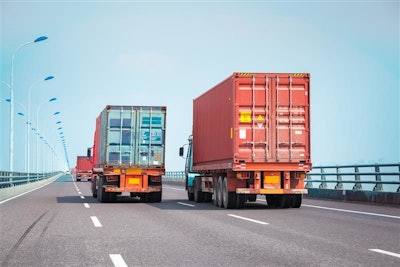
Supply chains are increasingly expensive. From raw materials to transportation, the price of just about everything is going up. In March, the cost of crude oil spiked above $100 per barrel for the first time since 2014.
And we’re already seeing the effects, which make it tougher to navigate today’s biggest supply chain challenges. Barge operators are imposing emergency surcharges on each container to account for rising fuel prices. The Panama Canal Authority has proposed a fee on empty containers being returned to Asia to incentivize efficiency. In the U.S., the Ocean Shipping Reform Act just passed the House of Representatives, the next step in addressing shippers’ complaints about excessive detention and demurrage charges.
All of these are signs of an inflection point for you to re-evaluate your business plan and optimize your supply chains. There’s a lot of focus and resources put into the final mile of the supply chain so that customers have visibility, but we need more of an emphasis on the earlier stages. That’s where most of the complexity is, and where there are cost savings to be had.
Regionalizing production may simplify these stages to some extent, but doesn’t address the rising cost of fuel required for transportation. Organizations need to leverage what they have available to them. Instead of only utilizing half the space of a truck, it would be more efficient to co-load and fill the whole trailer to get the best use of that fuel. Every extra pallet of cargo or cubic foot on a container is potential savings.
Analyzing data is the key to finding these efficiencies and unlocking savings, but it’s not as simple as it might sound. Here’s how organizations can use the information they have to anticipate what’s coming and optimize their supply chain efforts.
Make sure you have the right data
Supply chain optimization is about having the most accurate data and knowing how to analyze it to create the most efficient processes. Getting that data can be a challenge—this is particularly an issue with ocean freight—but making different parties accountable for their parts can create a clearer data picture.
Often that picture is muddied because a clear division of tasks and movements has created silos. The team that’s responsible for port-to-port transportation is likely different from the team that moves between a port and distribution center, or the final mile.
The right data can inform a holistic view of the supply chain and logistics orchestration technology can determine the most efficient way to flow cargo.
Unfortunately, supply chains are rarely predictable. You may have to make many last-minute decisions after a lead time has evaporated, but data can help you more easily reach a conclusion.
If data tells you what’s coming and going, you can better determine what is critical and what can wait. It’s common for an organization to fly cargo out only to sit in a warehouse for months. Having data on your replenishment orders and sales can inform whether it’s truly critical to make that air freight request.
Optimize assets with flow management
Reviewing lead times can go a long way toward optimizing your shipping processes, specifically getting the best use out of containers that seem to be less and less available. Data collected using logistics orchestration technology can give you the best picture of whether you have the right lead times in your system, so you don’t have to scramble to make your deadlines and can have flexibility to streamline operations.
Too many organizations are trying to obtain capacity to keep up with demand, but don’t actually utilize all their equipment to the fullest and overspend on things like shipping multiple containers. Instead of having to ship three containers, logistics orchestration technology may reveal efficiencies that allow you to only ship two. Data can inform flow management so you can de-risk by doing more at an origin and allowing flexibility down the road.
This is true for other assets, as well. Optimization allows us to not overburden processes, teams, and assets that are already stressed. In turn, we can facilitate as much as possible downstream by grouping cargo orders to reduce touch points, storage, or additional costs all while hitting the latest requested delivery date.
This requires a different mindset, but the payoff is there. Through data, you can create a competitive advantage in the face of rising costs.
Assume your average utilization is 40%. How much would you save if data-informed decision-making could increase that utilization by even 10%? This has the power to dramatically create efficiencies for your organization where you use fewer containers, and therefore fewer trucks, reducing the elements of your supply chain.
Click here to hear more about driving efficiency on the road:
Recognize the inflection point
The ultimate goal is to get your products closer to the all-important last mile in the most efficient, cost effective way possible. This was always true, but the stakes are higher given the rising costs that nearly every organization is dealing with as fuel tops all the categories in the U.S. Bureau of Labor Statistics’ consumer price index, up 70% over last year. To optimize your efforts and realize the savings opportunity, you need to ask yourself some important questions about business strategy as you think about what happens along every step of your supply chain.
Where do your replenishment orders stand? How long did your last shipment wait in a distribution center before it actually traveled? Putting these data points in context can inform where you should optimize your supply chain.
Analyzing the data is easier with logistics orchestration technology, and can create a holistic view of your supply chain to offer a more-informed picture than you previously had. As costs like fuel keep surging, it’s time to think differently. The new flow management, informed by data, can provide savings at a time when everything seems to be more expensive.



![Pros To Know 2026 [color]](https://img.sdcexec.com/mindful/acbm/workspaces/default/uploads/2025/08/prostoknow-2026-color.mduFvhpgMk.png?auto=format%2Ccompress&bg=fff&fill-color=fff&fit=fill&h=100&q=70&w=100)







![Pros To Know 2026 [color]](https://img.sdcexec.com/mindful/acbm/workspaces/default/uploads/2025/08/prostoknow-2026-color.mduFvhpgMk.png?ar=16%3A9&auto=format%2Ccompress&bg=fff&fill-color=fff&fit=fill&h=135&q=70&w=240)




